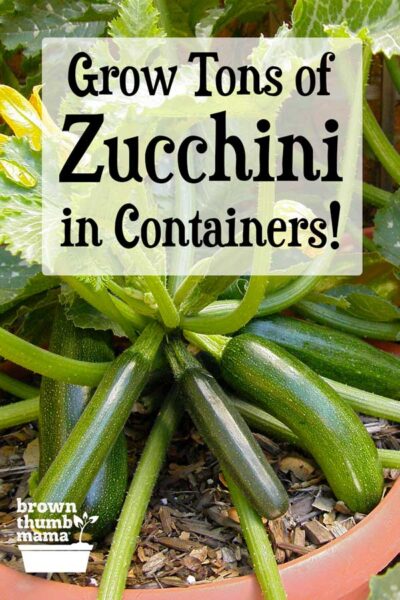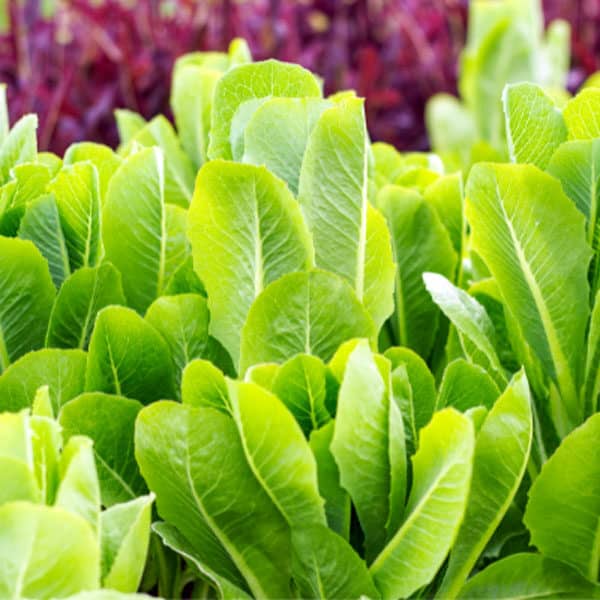This post may include affiliate links.
If you make a purchase, I'll earn a small fee at no extra cost to you.
Yes, you can grow zucchini or summer squash in pots or containers! This family favorite is easy to grow and will give you a huge harvest. Here’s everything you need to know to grow zucchini in containers.

Zucchini (also called summer squash) is a great vegetable for small-space gardeners. In fact, it’s one of my 5 Favorite Vegetables for Container Gardening. Zucchini is nearly guaranteed to grow, it produces tons of veggies all summer long, and comes in lots of fun shapes and colors.
Are you a brand new gardener? Not sure what to plant or when to plant it? I can help.
You’ll find lots of great information in my new book, The First-Time Gardener: Container Food Gardening.
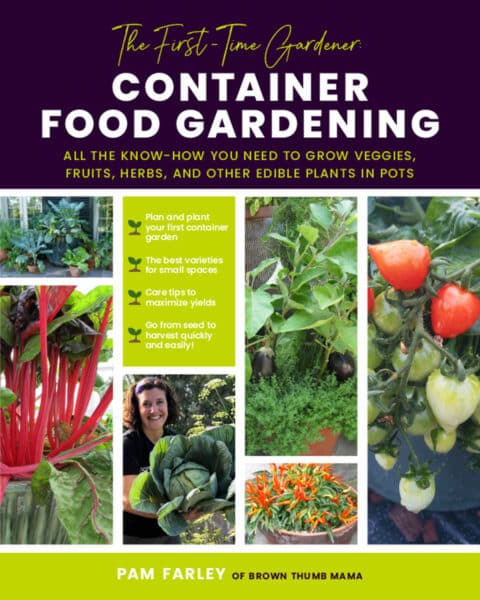
Summer squash has a mild flavor that makes it a family favorite, whether breaded and fried, grated and turned into zucchini fritters, added to soups, or made into zucchini bread.
This popular garden vegetable has a good combination of nutrients, including vitamins A, C, and K, folate, manganese, and potassium. Most of these nutrients reside in the skin–and the darker the zucchini, the more nutrients it has.
You’ll have the most success growing the compact, “bush type” zucchini in containers. My favorites are:
You can learn more about each of these zucchini varieties here. Let’s get growing!

Planting Zucchini: Sun, Water, Soil
The great part about growing zucchini in containers is that you can place your pots anywhere in your yard, to get the best sunlight. Zucchini needs 6 or more hours of sun each day for maximum growth.
When planting in containers, the soil can dry out fairly quickly. It’s a good idea to mulch the soil to conserve water, as in the picture below.
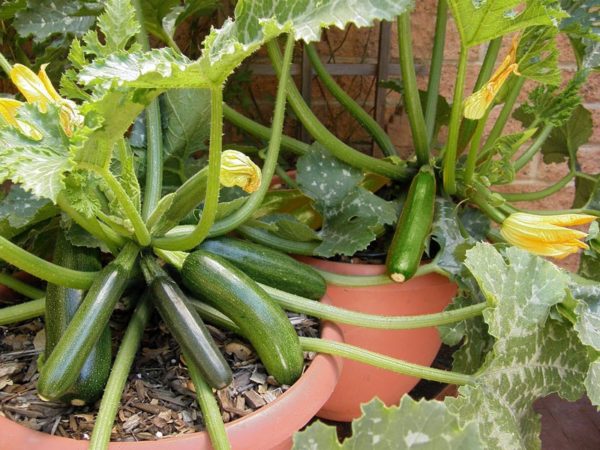
You may need to water daily–stick your finger in the soil before watering. If the soil is damp or wet about two inches below the surface, you don’t need to water. If the soil is dry, then water the base of the plant gently with a rain wand (I love my Dramm Rain Wand) or a watering can. Don’t water the leaves because it can encourage powdery mildew (see below), which can ruin your plants.
The leaves may wilt on a hot day, but this doesn’t mean they need to be watered right then–it’s how the plants conserve water. The leaves should be refreshed by the morning.
Please don’t scoop up a bunch of dirt from your yard for your container of zucchini. Garden soil is too dense and could have fungus, microbes, seeds, bugs, or other critters that will damage your plants.
It’s important to choose the right soil for your container garden, so your vegetables will grow well. Because the plants are growing in a confined space, you want to be sure the soil is the very best it can be. Here’s how to choose the best soil for your container garden.
Planting & Spacing
Because zucchini has relatively shallow roots, you’ll need a container with drainage holes that’s about 12 inches deep and at least 12 inches across (approximately 15 gallons).
I particularly like this planter from Bloem which has a self-watering insert. If you think you’ll need to move your pots during the growing season, you can also get this nifty rolling saucer to put under the planter.
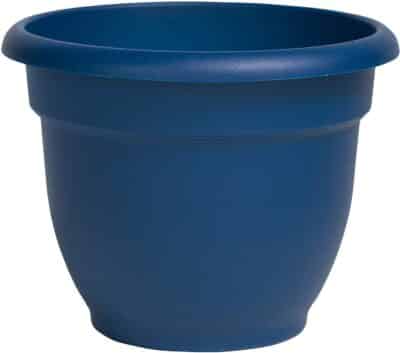
Plant your zucchini seeds or seedlings in the spring, when soil temperature is between 70-85°F. Not sure when you should plant? You need a vegetable planting schedule that’s customized for your area and climate. Click the image to get one for your garden.

If you’re planting from seed, make a hole about 1” deep, plop the seed inside, and pat the soil over gently. Your seeds will sprout in 7-10 days. If you’re planting a seedling, make a large hole about 2” deep, loosen the roots of the seedling, and place into the hole. Fill the hole with soil and pat gently.
All squash plants have large leaves and really like to spread out. Plant one zucchini per pot, so there’s room for the roots to grow and for the leaves to spread.
Zucchini plants need pollinators. If you don’t have a lot of bees in your garden, plant some early-blooming flowers like borage or alyssum near your squash. You can plant them in the same pot, or in a neighboring pot. The bees will find their way regardless. 🙂

Pests & Diseases
Unfortunately, there are a handful of bugs who like to eat zucchini. The most common ones are squash bugs, vine borers, and cucumber beetles. Most of these can be controlled or managed by natural methods.
Squash bugs are common in the garden, because they like to eat zucchini, pumpkins, winter squash, even cucumber. They lay tiny eggs in neat little lines on the underside of leaves–if you see these, squish ‘em.
In fact, if you see them at any stage of their life cycle, it’s best to squish them. Here’s more info on how to get rid of squash bugs naturally.

Vine borers spend the winter in the soil and lay their eggs at the base of the stem. Then the caterpillars hatch, bore a hole into your tender seedling, and eat it to death. Because you’re using fresh soil just for container gardening, these shouldn’t be a problem for you.
But just in case–here’s how to prevent squash vine borers naturally.
Cucumber beetles look like ladybugs, but they’re yellow and black instead of red and black. They spread disease, so if you see them you want to get them under control ASAP. Spinosad is a soilborne bacterium that is helpful for this.
Powdery mildew is a fungus that could infect your plants (usually near the end of the season). The leaves look like they’re covered with a white or gray powder.
Treat infected plants with neem oil spray or–believe it or not–milk. Mix 1 cup of milk and 1 cup of water; add a few drops of dish soap and spray the plant 1-2 times per week. Do not compost the plants after harvest.

When & How to Harvest Zucchini
Your zucchini will be ready to harvest about 6-7 weeks after planting. Pick them when they’re small to ensure tender fruit and small seeds.
Cut the stem of the zucchini with scissors or pruners, rather than pulling it off the plant. Cutting the stem prevents damage to the plant and delays mold developing on the zucchini.

Summer squash plants grow like crazy. I’ve had a single zucchini plant grow as many as 15 squash over one gardening season! They are the vegetable that just keeps giving.
Harvest zucchini frequently; it seems they grow from “normal size” to “baseball bat size” overnight. At the height of the season, check your plants every day. They’re still edible when large, but will be mealy with large seeds. This is an example of a squash that got way too big.
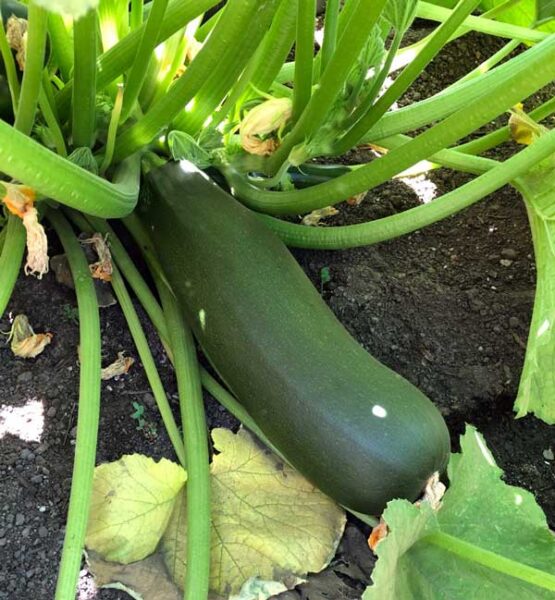
Preserve Your Harvest
If you’ve grown more zucchini than you can eat, there are several ways to preserve your harvest. I like to grate the zucchini and freeze it in 2-cup amounts. Then it’s ready for zucchini bread, or adding to homemade spaghetti sauce or soup.
You can also dehydrate summer squash, but canning is not a good idea. You may read different articles about water-bath canning or pressure canning zucchini–but no safe guidelines have been established, and botulism is no joke. Play it safe and freeze or dehydrate instead.
Don’t feel like freezing or drying your harvest? Share your bounty with your local food bank! Food banks don’t often get donations of fruits and vegetables, and their clients will welcome the fresh food. You can find your local food bank at Feeding America.org.
You can also give a bit to your friendly local tortoise, as a yummy treat.

